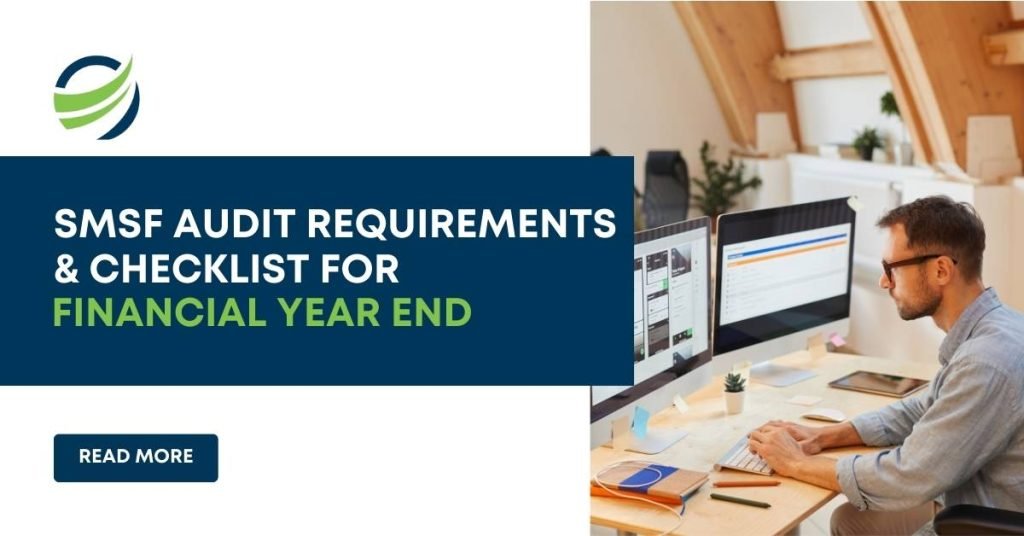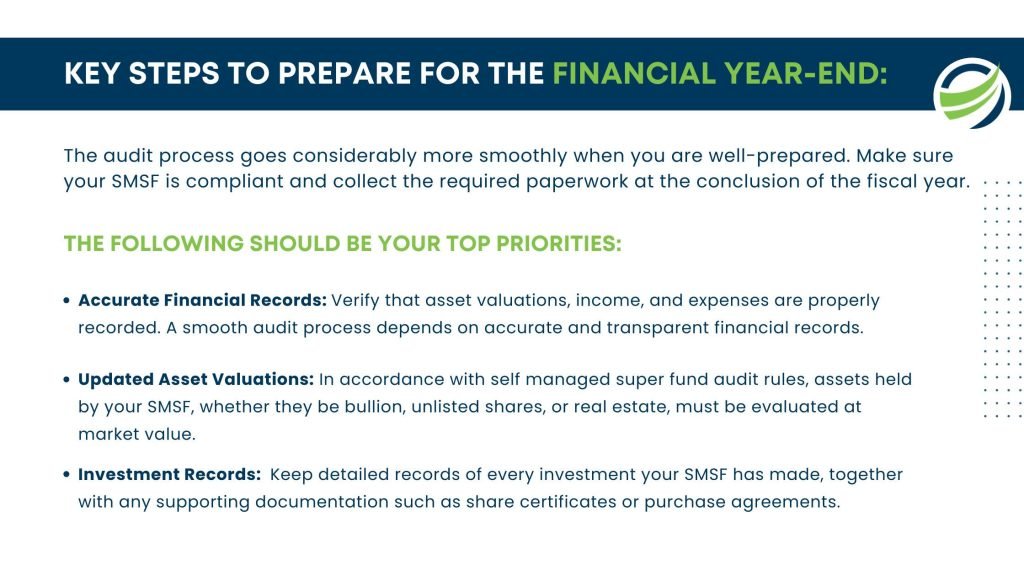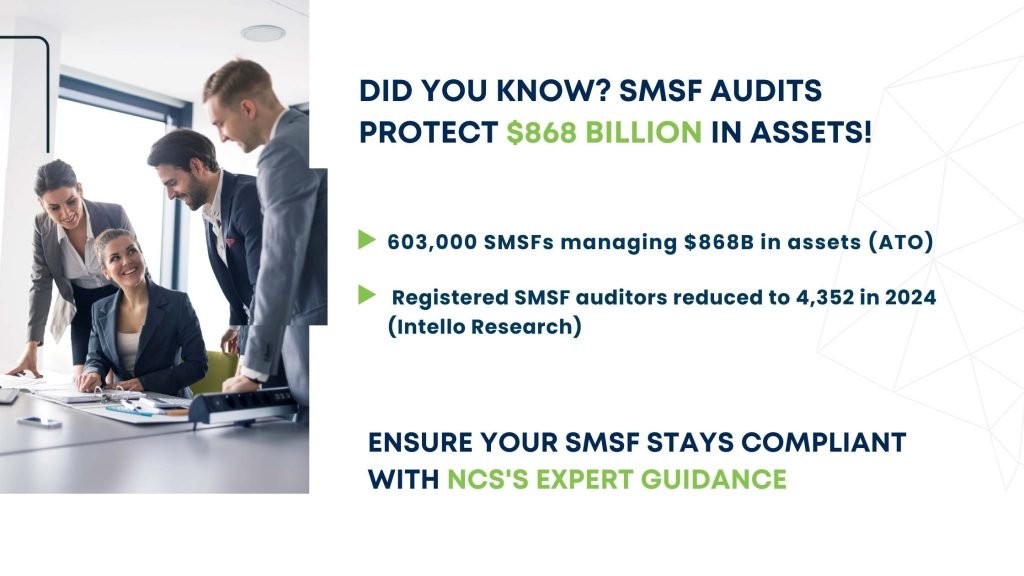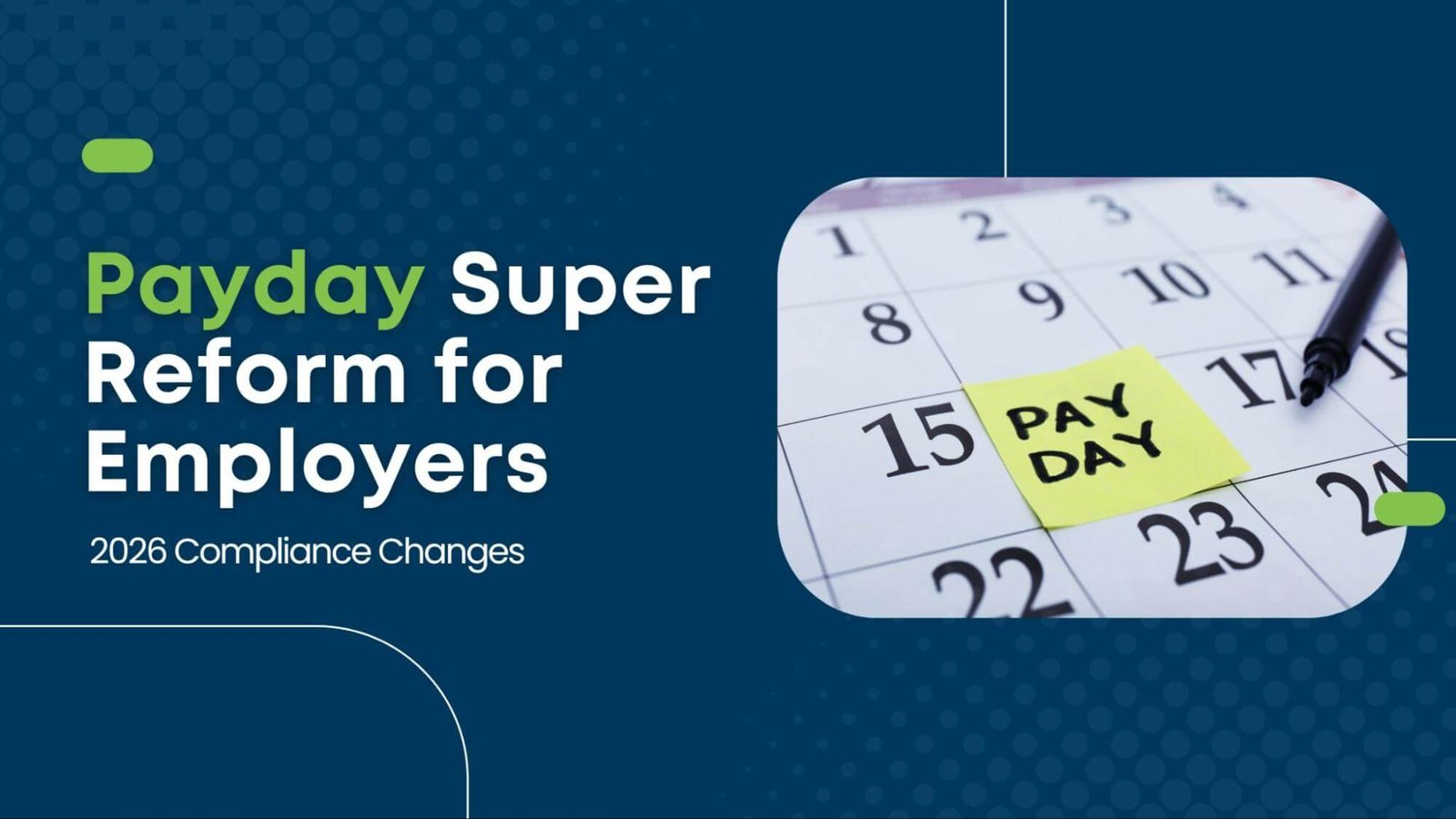
SMSF Audit Requirements & Checklist for Financial Year End
- Aesha Shah
- January 22, 2025
- 6 minutes
SMSF Audit Requirements & Checklist for Financial Year End
Managing a self-managed super fund (SMSF) gives you control over your retirement savings, but it also brings responsibilities. One of the key duties for trustees is making sure the fund undergoes an annual audit as mandated by the SMSF audit requirements set by the Australian Taxation Office (ATO).
As the fiscal year-end approaches, proper preparation is vital to ensure compliance and a smooth audit process. Here’s everything you need to know about SMSF audit requirements and how to prepare effectively.
Why SMSF Audits Are Important?
An SMSF audit is required legally under the Superannuation Industry Supervision Act (SISA). A self managed super fund audit isn’t just a box-ticking exercise. It guarantees adherence to the Australian regulations and protects your fund’s integrity. According to the Australian Taxation Office 603,000 SMSFs manage over $868 billion in assets. By reviewing your SMSF’s financial and compliance records, an audit helps trustees avoid costly violations or penalties.
Audits offer comfort in addition to fulfilling legal requirements. They aid in the early detection of such problems, guaranteeing that the investments and strategies of your fund stay in line with both long-term financial objectives and legal obligations.
If you’re looking for expert assistance in managing your SMSF, explore Self Managed Superannuation Fund Services to ensure your fund operates smoothly and remains compliant with all legal obligations.
Key Steps to Prepare for the Financial Year End:
The audit process goes considerably more smoothly when you are well-prepared. Make sure your SMSF is compliant and collect the required paperwork at the conclusion of the fiscal year. The following should be your top priorities:
- Accurate Financial Records: Verify that asset valuations, income, and expenses are properly recorded. A smooth audit process depends on accurate and transparent financial records.
- Updated Asset Valuations: In accordance with self managed super fund audit rules, assets held by your SMSF, whether they be bullion, unlisted shares, or real estate, must be evaluated at market value.
- Investment Records: Keep detailed records of every investment your SMSF has made, together with any supporting documentation such as share certificates or purchase agreements.

Comprehensive SMSF Audit Checklist:
Here is a helpful checklist designed to satisfy the SMSF audit standards in order to streamline the process:
Statements of Financial Position:
Make sure your financial statements accurately reflect all of your transactions, earnings, and outlays.
Compliance with Trust Deeds:
Verify that every SMSF action confirms the guidelines specified in your trust deed.
Contributions to superannuation:
Confirm that contributions do not exceed either the concessional or non-concessional caps, as specified by law.
Documentation for an Investment Strategy:
Make sure your fund’s investing plan complies with the sole purpose test by keeping proper records of it.
SMSF Property Compliance:
Verify that any real estate owned by your fund conforms with related party regulations and market rent valuation.
Documentation of Transactions:
All SMSF transactions should have their contracts, invoices, and receipts kept on hand so they may be easily reviewed during the audit.
Special Audit Considerations:
Owning property within your Self-Managed Super Fund (SMSF) requires specific commitment. Properties are required to be rented at market rates and must undergo independent valuation at a minimum of once per year. In cases where the property is rented to a related party, trustees must guarantee that the rental agreement complies with SMSF audit standards to prevent violations of in-house asset regulations.
Proper documentation is required in this context. It is important to maintain an organised and current tenancy agreements, records of rental income, and valuation reports to reduce the risk of audit delays or compliance challenges.
Auditing Unlisted Investments:
When a Self-Managed Superannuation Fund (SMSF) invests in unlisted assets, including shares in private companies, the compliance requirements become increasingly intricate. These unlisted investments are required to satisfy the sole purpose test, avoid violations related to transactions with related parties, and be independently valued to accurately represent their fair market value.
Auditors will conduct a thorough examination of these investments to ensure compliance. To facilitate this process, it is essential to keep comprehensive records of valuation reports, share certificates, and any additional documentation that substantiates the alignment of these assets with the investment strategy of your SMSF.
Commodities and Bullion Audits:
SMSFs that hold physical commodities or bullion, such as gold or silver, are subject to strict documentation and storage protocols. Clear ownership must be established, and the assets must be stored securely.
For bullion that is held on exchanges, auditors will review transaction records and confirm that the market value is accurately represented. Maintaining these records actively will keep the audit process up to date and help avoid compliance issues.
Importance of Auditor Independence:
The independence of your superannuation fund auditors is critical to ensuring a fair and impartial review of your SMSF. Recent updates to the SMSF auditor CPD requirements have placed greater emphasis on maintaining auditor professionalism and independence. These changes aim to restore confidence in the auditing process and protect trustees from conflicts of interest.
For more insights into managing your SMSF effectively, check out Cracking the SMSF Code: How NCS Australia Transforms Outsourcing into a Retirement Power Move to unlock strategies for smarter SMSF management.
Key reforms introduced by the Australian government include:
- Structural Separation: Audit firms may need to separate auditing and consulting services to eliminate conflicts of interest.
- Governance Improvements: New standards focus on improving transparency and governance within audit firms.
- Training Requirements: Auditors must meet the latest SMSF auditor CPD requirements to stay updated on regulatory changes and compliance expectations.
The Australian government has recently introduced stricter rules to uphold auditor independence. These changes are crucial, especially given the decline in the number of registered SMSF auditors, which has dropped from over 7,000 in 2014 to approximately 4,352 in 2024 as per the intello research report
These reforms aim to improve transparency, governance, and the quality of self managed super fund audits, ensuring trustees receive impartial and professional audit services.

The Role of Internal Audit Checklists:
External audits are required by law, but utilising an internal audit checklist can assist trustees in getting their fund ready for evaluation. Performing internal assessments before hiring a registered auditor guarantees that your fund’s documentation is organised, which saves time and helps avoid compliance issues.
An effective internal audit checklist should include financial documentation, asset assessments, investment plans, and adherence to contribution regulations. This forward-thinking strategy minimises the likelihood of mistakes and builds trust in the management of your fund.
Common Pitfalls to Avoid During Audits:
Errors in an audit can result in serious penalties, making it crucial to steer clear of typical mistakes. Key areas to watch out for include:
- Insufficient Documentation: Not supplying enough proof for transactions, valuations, or investments can delay the audit process and create compliance issues.
- Related Party Violations: Transactions involving related parties must adhere to strict regulations to prevent penalties.
- Non-Compliant Investments: Investments that stray from the fund’s strategy or do not meet the sole purpose test can raise red flags with auditors.
By proactively tackling these concerns, you can make it an easy and effective audit.
Conclusion:
Preparing for an SMSF audit requires meticulous planning and organisation, it can be a straightforward process. By adhering to the SMSF audit requirements, using an internal audit checklist, and staying informed about recent changes to SMSF auditor CPD requirements, you can ensure your fund remains compliant.
Audits are more than just a regulatory obligation; they help protect your SMSFs integrity and keep your retirement savings secure. With the right approach, you can meet compliance standards while safeguarding your financial future.
Navigating SMSF audits with precision is key to protecting your financial future. At NCS Australia, we bring unparalleled expertise to ensure your compliance and enhance the integrity of your fund. Let’s work together to achieve audit excellence—reach out to us and elevate your SMSF management today.
FAQs:
1. Why do I need an SMSF audit?
An SMSF audit is required under SISA to ensure your fund complies with Australian regulations. It protects the fund’s integrity, ensures proper management, and helps you avoid penalties or legal consequences related to non-compliance.
2. How often does my SMSF need to be audited?
You must audit your SMSF annually, usually after the financial year ends. Annual audits verify that your fund adheres to Australian regulations, ensuring compliance in areas like financial records, investment rules, and trustee responsibilities.
3. Can I perform an internal audit of my SMSF?
You can perform an internal review to identify issues before the official audit, but external audits are mandatory. An internal review helps you check financial records, ensure compliance with investment rules, and verify asset valuations, reducing the risk of penalties.
4. What happens if my SMSF doesn’t pass an audit?
Failing an audit can result in penalties or fund deregistration. Common issues include incomplete documentation, non-compliant investments, or breaches of related party rules. Addressing these problems promptly can help you avoid serious consequences.
5. Do I need an auditor to review my SMSF?
Yes, an independent, registered auditor must review your SMSF annually. This ensures compliance with Australian laws and guarantees impartiality. Auditors must meet continuing professional development (CPD) standards to maintain professional and unbiased reviews.
6. What are common mistakes during an SMSF audit?
Mistakes include poor record-keeping, non-compliant investments, and breaching related party rules. These errors can delay the audit process or lead to penalties. Careful planning and proper documentation can help avoid these pitfalls.








